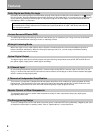
6
En
Introductory Information
Operating other PIONEER components
You can also control PIONEER components
(and those made by other manufacturers) by
pointing the amplifier’s remote control directly
at the respective component. This type of
operation does not require control cords. All
you have to do is recall the appropriate preset
code (Refer to “Recalling preset codes” on
page 20).
When Making Cable Connections
Be careful not to arrange cables in a manner that bends
the cables over the top of this unit as shown in the
illustration. If the cables are brought over this unit, the
magnetic field produced by the transformers in this unit
may cause a humming noise to come from the speakers.
Remote Control
Amplifier
To CONTROL IN
terminal of another
PIONEER component
bearing the Î mark.
PIONEER component
bearing the Î mark.
Connecting an optional control cord allows you to
operate other PIONEER components simply by pointing
the amplifier’s remote control at the remote sensor on
the front panel of the amplifier. The amplifier then sends
the remote control signals to the other devices via the
CONTROL OUT terminal.
Operating range of remote control unit
Remote control may not function properly if :
• There are obstacles between the remote
control and the remote sensor.
• Direct sunlight or fluorescent light is shining
onto the remote sensor.
• The amplifier is located near a device
emitting infrared rays.
• Operated simultaneously with another
remote control which uses infrared rays.
Point the remote control toward the remote sensor Î on
the front panel of this unit to operate. The remote control
unit will operate the amplifier for up to a distance of 7
meters within 30° angle on each side of the sensor of the
remote sensor as illustrated below.
OUT IN
CONTROL
OUT
IN
CONTROL
30
30
7m
memo
memo
(VSA-E03)


















